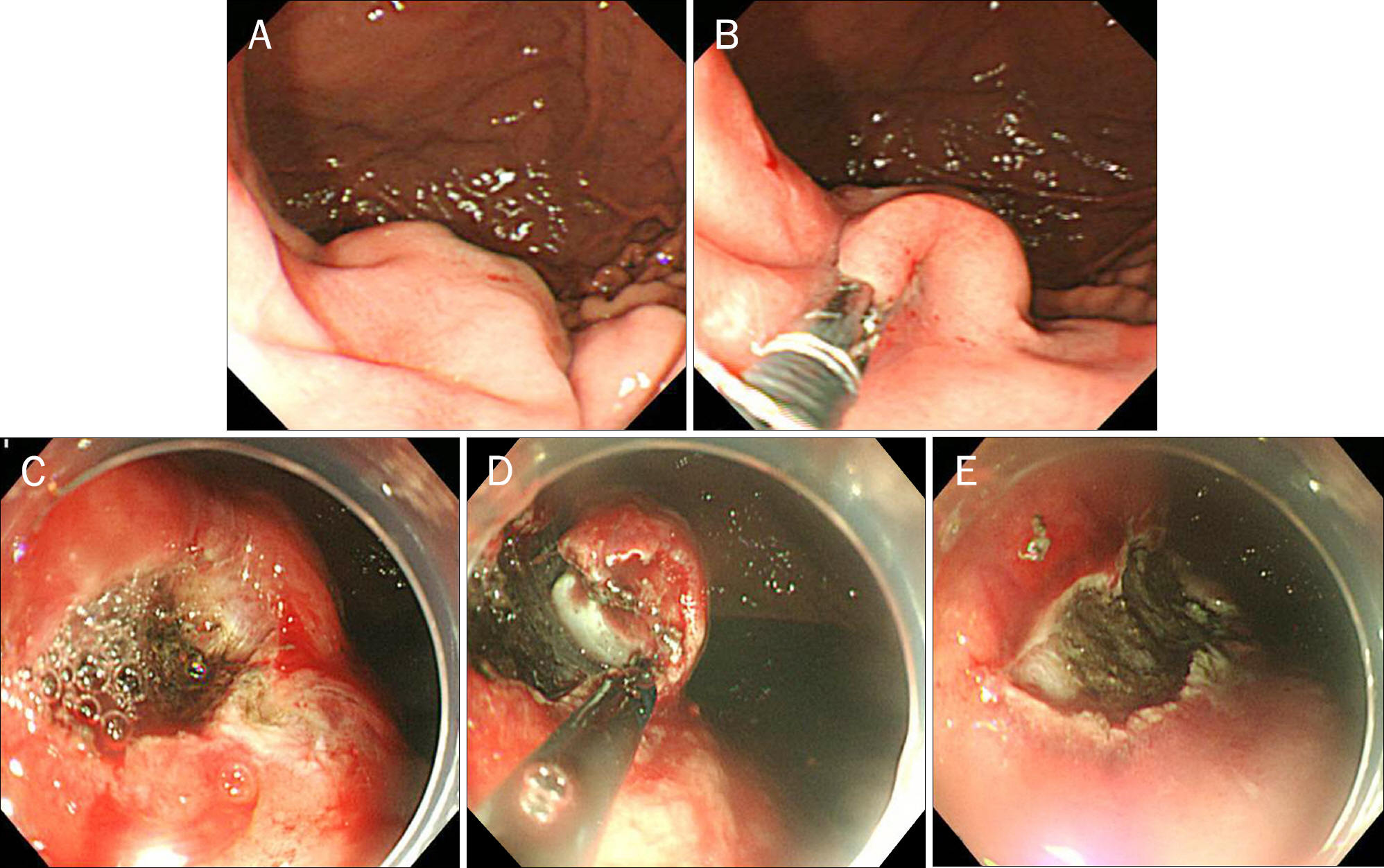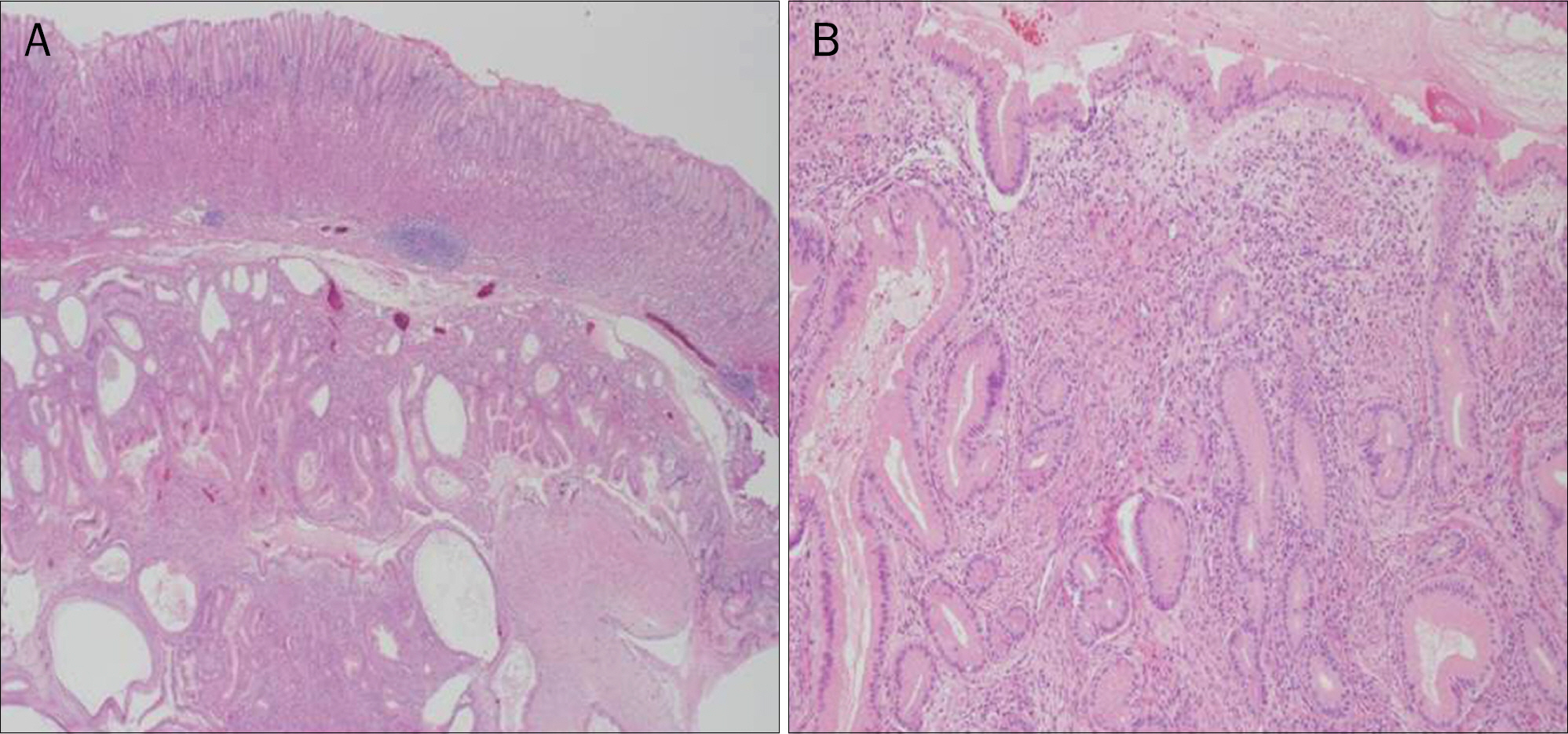Korean J Gastroenterol.
2016 Feb;67(2):98-102. 10.4166/kjg.2016.67.2.98.
Inverted Hyperplastic Polyp in Stomach: A Case Report and Literature Review
- Affiliations
-
- 1Department of Internal Medicine, Korea University College of Medicine, Seoul, Korea. gi7pjj@korea.ac.kr
- KMID: 2383548
- DOI: http://doi.org/10.4166/kjg.2016.67.2.98
Abstract
- An inverted hyperplastic polyp (IHP) found in stomach is rare and characterized by downward growth of hyperplastic mucosal component into the submucosa. Because of such characteristic, IHP can be misdiagnosed as subepithelial tumor or malignant tumor. In fact, adenocarcinoma was reported to have coexisted with gastric IHP in several previous reports. Because only 18 cases on gastric IHP have been reported in English and Korean literature until now, pathogenesis and clinical features of gastric IHP and correlation with adenocarcinoma have not been clearly established. Herein, we report a case of gastric IHP which was initially misdiagnosed as gastrointestinal stromal tumor and resected using endoscopic submucosal dissection. Literature review of previously published case reports on gastric IHP is also presented.
MeSH Terms
Figure
Reference
-
References
1. Yamashita M, Hirokawa M, Nakasono M, et al. Gastric inverted hyperplastic polyp. Report of four cases and relation to gastritis cystica profunda. APMIS. 2002; 110:717–723.
Article2. Kamata Y, Kurotaki H, Onodera T, Nishida N. An unusual heterotopia of pyloric glands of the stomach with inverted downgrowth. Acta Pathol Jpn. 1993; 43:192–197.
Article3. Itoh K, Tsuchigame T, Matsukawa T, Takahashi M, Honma K, Ishimaru Y. Unusual gastric polyp showing submucosal proliferation of glands: case report and literature review. J Gastroenterol. 1998; 33:720–723.
Article4. Katz LB, Tenembaum MM, Kreel I. Gastric hamartomatous polyps in the absence of familial polyposis: report of two cases. Mt Sinai J Med. 1982; 49:426–429.5. Hanada M, Takami M, Hirata K, Kishi T, Nakajima T. Hyperplastic fundic gland polyp of the stomach. Acta Pathol Jpn. 1983; 33:1269–1277.
Article6. Carfagna G, Pilato FP, Bordi C, Barsotti P, Riva C. Solitary polypoid hamartoma of the oxyntic mucosa of the stomach. Pathol Res Pract. 1987; 182:326–330.
Article7. Aoki M, Yoshida M, Saikawa Y, et al. Diagnosis and treatment of a gastric hamartomatous inverted polyp: report of a case. Surg Today. 2004; 34:532–536.
Article8. Kono T, Imai Y, Ichihara T, et al. Adenocarcinoma arising in gastric inverted hyperplastic polyp: a case report and review of the literature. Pathol Res Pract. 2007; 203:53–56.
Article9. Ono S, Kamoshida T, Hiroshima Y, et al. A case of early gastric cancer accompanied by a hamartomatous inverted polyp and successfully managed with endoscopic submucosal dissection. Endoscopy. 2007; 39(Suppl 1):E202.
Article10. Odashima M, Otaka M, Nanjo H, et al. Hamartomatous inverted polyp successfully treated by endoscopic submucosal dissection. Intern Med. 2008; 47:259–262.
Article11. Kim HS, Hwang EJ, Jang JY, Lee J, Kim YW. Multifocal adenocarcinomas arising within a gastric inverted hyperplastic polyp. Korean J Pathol. 2012; 46:387–391.
Article12. Lee SJ, Park JK, Seo HI, et al. A case of gastric inverted hyperplastic polyp found with gastritis cystica profunda and early gastric cancer. Clin Endosc. 2013; 46:568–571.
Article13. Jung M, Min KW, Ryu YJ. Gastric inverted hyperplasic polyp composed only of pyloric glands: a rare case report and review of the literature. Int J Surg Pathol. 2015; 23:313–316.14. Choi MS, Jin SY, Kim DW, Lee DW, Park SM. A case of gastric inverted hyperplastic polyp associated with gastritis cystica profunda and early gastric carcinoma. Korean J Pathol. 2007; 41:55–58.15. Lee KM, Kim JH. Endoscopic treatment of gastric adenoma with argon plasma coagulation. Pascu O, editor. Therapeutic gastrointestinal endoscopy. Rijeka, Croatia: InTech;2011. p. 33–56.
Article
- Full Text Links
- Actions
-
Cited
- CITED
-
- Close
- Share
- Similar articles
-
- A Case of Gastric Inverted Hyperplastic Polyp Found with Gastritis Cystica Profunda and Early Gastric Cancer
- A Case of Gastric Inverted Hyperplastic Polyp Associated with Gastritis Cystica Profunda and Early Gastric Carcinoma
- Two Cases of Adenocarcinoma Arising from Gastric Hyperplastic Polyp
- Gastric Inverted Hyperplastic Polyp Removed Using Endoscopic Submucosal Dissection
- A Giant Hyperplastic Polyp of the Stomach Complicated by Intussusceptions and Intraepithelial Malignant Transformation




